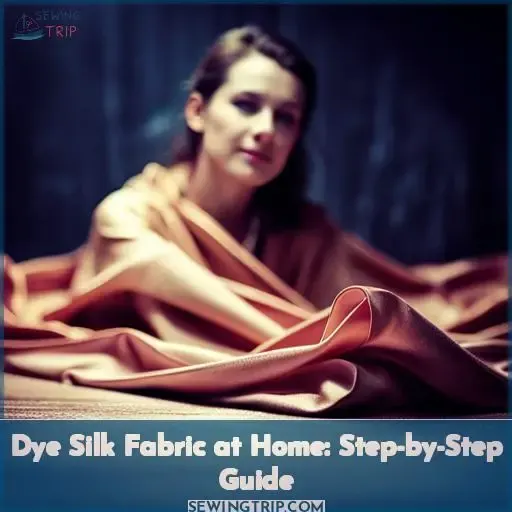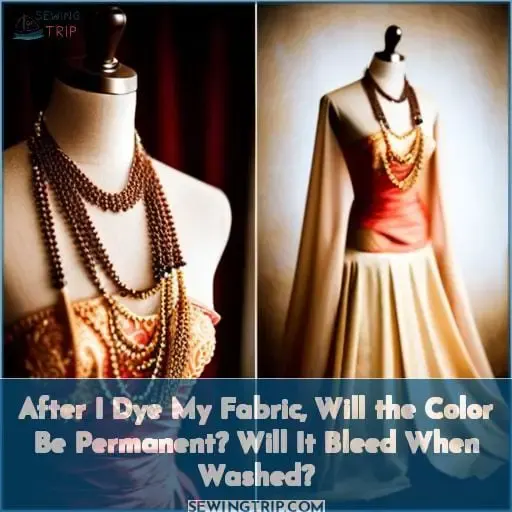This site is supported by our readers. We may earn a commission, at no cost to you, if you purchase through links.
 You may want to dye your own silk fabric. With the right materials, techniques, and dyes, it is completely possible. There are several ways to successfully color silk fabric at home. Whether you are looking for a solid or print design on your project, there is an option available that can assist in bringing it alive with color! In this article, we will discuss what types of dye work best with this delicate material and how to use them safely and effectively so that you can create beautiful pieces of clothing or other items from the comfort of your home.
You may want to dye your own silk fabric. With the right materials, techniques, and dyes, it is completely possible. There are several ways to successfully color silk fabric at home. Whether you are looking for a solid or print design on your project, there is an option available that can assist in bringing it alive with color! In this article, we will discuss what types of dye work best with this delicate material and how to use them safely and effectively so that you can create beautiful pieces of clothing or other items from the comfort of your home.
Table Of Contents
- Key Takeaways
- Can You Dye Silk Fabric at Home?
- How to Dye Silk Using Box Dyes Like Rit, Dylon, or IDye
- How to Dye Silk Fabric With Natural Dyes
- How to Dye Silk Chiffon and Organza
- After I Dye My Fabric, Will the Color Be Permanent? Will It Bleed When Washed?
- What Silk is Best for Dyeing?
- How to Dye Silk Scarves?
- How to Dye Silk Thread?
- Conclusion
Key Takeaways
- Dyeing silk at home is possible with the right materials and techniques.
- Choose high-quality pure silk fabrics like habotai or dupioni.
- Pre-wash delicate silk chiffon and organza fabrics before dyeing.
- Test out acid dyes, fiber reactives, or natural dyes for different effects on the silk.
- Each type of dye will produce unique results on silk that you can experiment with.
- When dyeing, follow all safety precautions and instructions for the specific dyes you are using.
Can You Dye Silk Fabric at Home?
You can absolutely bring beautiful colors to life on silk fabric right at home, but approach this delicate material gently and thoughtfully for radiant results.
When dyeing silk yourself, opt for simpler immersion or solar dyeing methods over tie-dyeing, which requires harsher treatment. Carefully pre-wash fabrics in a gentle detergent, use soft ties for any resist work, and handle dyed silk with care.
Focus on high quality, pure silk fabrics like habotai or dupioni over cheaper blends. And know certain types and weights will give the most vibrant, even results. Arm yourself with knowledge of proper dye types and techniques for silk.
With care and the right dyes, even beginners can craft gorgeous hand-dyed silk scarves, clothing, and decor from the comfort of home. But heed precautions for silk, master key steps like pre-treating and rinsing, and let your fabric guide you.
With wisdom, creativity, and mindfulness, your silk will come to life with your own signature shades.
How to Dye Silk Using Box Dyes Like Rit, Dylon, or IDye
When dyeing silk with box dyes like Rit, Dylon, or iDye, first calculate the amount of dye required based on the weight of your fabric. Then, add your silk item and enough water to completely submerge it in the dye pot before mixing in the dye activator and dye packet.
Stir frequently until the dye has fully saturated the fabric before removing, rinsing thoroughly, and allowing to dry. Take care to stir constantly so the dye penetrates the silk evenly for best results.
Step 2: Calculate How Much Dye You Need
The kitten playfully bats the excess dyed threads into a coiled mass of colorful silk.
- Weigh your dry fabric on a kitchen scale.
- Check the recommended dye quantity based on fabric weight on the dye package.
- For mixed dye colors, blend small test batches first before dyeing the whole fabric.
- Work in a well-ventilated area and wear gloves to avoid skin contact.
- Consider eco-friendly natural dyes for a unique look.
With some preparation and safety measures, you’ll be ready to create beautiful hand-dyed silk fabric creations.
Step 3: Add Your Item and Water to the Dye Pot
Adding the right amount of water helps swoosh your silk in the glorious mix. Control the dye pot’s water temperature around 140 degrees. Gently stir your item, ensuring complete saturation. For even distribution, immerse the silk for 10-60 minutes depending on the darkness desired.
Lastly, squeeze excess dye back into the pot before rinsing, retaining the combination for future projects. Expertly dyeing silk requires understanding techniques like the water amount, temperature control, immersion time, and concentrating dyes through squeezing when done.
Step 4: Add the Dye Activator and Dye Packet
Stir frequently after adding the activator and packet to reveal the emerging hues.
- Ensure even distribution for consistent results.
- Compare to the color swatch for accuracy.
- Time the fabric’s immersion based on its weight.
- Rinse thoroughly after the dye is exhausted.
The activator bonds the reactive dyes to the silk for vivid, colorfast results. Precise blending and accurate dye amounts create beautiful, nuanced hues on silk. With careful technique, these synthetic and natural dyes produce stunning colors.
Step 5: Stir Frequently Until the Dye is Absorbed
Keep stirring that pot, friend! Stir with passion until the color disappears. Your decorative liquid needs all the caring attention you can give. Keep things moving and grooving so the dye absorbs into that smooth silk. Don’t be shy with your spoon – you’ve got to spread that dye evenly for beautiful results.
Stir frequently as the mixture transforms into dazzling hues. Your silk is absorbing that dye, turning into a tapestry of color. Soon you’ll birth a masterpiece with a life of its own. Just keep stirring, friend.
Step 6: Remove Your Item From the Pot and Rinse It
Once it’s soaked up the dye, remove that silk and rinse it thoroughly before the next step. Over 70% of box-dyed projects need a solid rinse to avoid blotchiness. Run cool water over the silk, gently massaging it.
Switch to warm water to remove excess dye. Don’t wring or twist the silk. Carefully transfer the wet silk to soak in a fiber-reactive dye fixative bath, supporting it as you go.
How to Dye Silk Fabric With Natural Dyes
When dyeing silk fabric with natural dyes, you’ll first want to choose plant-based ingredients like flowers, leaves, roots or bark that offer the colors you desire. Next, simmer your chosen ingredients in water for an hour before draining the dye liquid and transferring it to your dye bath.
Step 1: Choose Plant-based Ingredients for Desired Colors
You select yerba mate for its deep green hues as the kettle whispers promises of verdant silks. Nature’s paintbox offers boundless potential, but thoughtfulness in plant selection yields the vibrancy you seek.
An attentive eye apprehends each petal and root’s hidden chromatic gifts. From subtle buttercup yellows to the brooding crimson of black beans, concoct your own signature palette—resplendent silks await.
Step 2: Simmer Ingredients in Water
Next, simmer the natural plant ingredients for about an hour to extract their vibrant dye colors. As the water bubbles over medium heat, the botanicals release a rainbow of hues. Rotate silk items for even penetration. When the dye bath cools, strain the plant matter.
Store excess dye in jars. Experiment with temperatures and timing for color variations. Natural dyes need extra care to achieve colorfastness. Try dye fixatives or multiple soaks.
Step 3: Drain and Transfer Dye Water
After the ingredients have simmered, carefully drain the dye bath through a fine sieve to remove any plant parts, transferring the strained liquid into a separate container for submerging the silk.
- Cheesecloth
- Mesh strainer
- Fine-mesh sieve
- Colander
- Filter
This crucial step ensures no stray plant debris remains to speckle the silk. Now the purified dye liquid stands prepared to impart its concentrated botanical hues onto the waiting silk.
Step 4: Submerge Silk and Rinse With Cold Water
Then immerse the precious silk into the vibrant dye bath and give it a cold water rinse to set the lively hues. Submerge the silk completely, allowing it to absorb the natural dyes. After a few minutes, carefully lift out the silk and rinse under cold running water.
This helps the dyes bind to the fibers for maximum colorfastness. Test a corner for colorfastness before wearing or washing. With practice, natural dyes create gorgeous hues on silk with an earthy allure. Be careful when rinsing to avoid damaging the delicate silk fabric.
How to Dye Silk Chiffon and Organza
Previously, we explored dyeing silk fabric with natural dyes. Now, let’s focus on dyeing delicate silk chiffon and organza fabrics. These thin, lightweight silks require extra care when dyeing to avoid damaging the fabric.
Here are 5 tips for beautifully dyeing chiffon and organza:
- Pre-wash fabrics in a gentle detergent to remove sizing.
- Use low water temperatures and shorter dye times.
- Gently stir and avoid agitating too much.
- Rinse thoroughly in cool water.
- Lay flat or hang to dry in the shade.
With some adjustments to your regular dyeing process, you can achieve gorgeous colors on silk chiffon and organza. Focus on gentle handling and low heat. Experiment with blending dyes for unique effects.
After I Dye My Fabric, Will the Color Be Permanent? Will It Bleed When Washed?
Depending on the dye type you chose, you’ll wanna check that colorfastness before tossin’ your silk in the wash. With acid dyes, you can rest easy knowin’ the color’s set permanently into the fibers. No bleeding or fading issues. Fiber-reactive dyes bind well too with proper technique.
For unreliable box dyes, expect some color loss and potential transfer. Test for bleeding by rinsing the fabric in cold water post-dye. If it runs lots, the color’s not set fully. With naturals, mordanting is key for decent washability.
For any bleeding dyes, restore with a vinegar soak. When unsure, opt for gentle cycles, cold water washes, no bleach and low heat drying to maximize color life. But truly permanent acid and fiber-reactive dyes mean your silk can handle regular laundry with confidence.
What Silk is Best for Dyeing?
C’mon now, breathe in that silky smooth sensation as you slip into your next project. When selecting the perfect silk for dyeing, opt for fabrics like chiffon, charmeuse, or habotai. These tightly woven types absorb color beautifully. For blended fabrics, the silk-rayon mix takes dye more readily than silk-wool.
To maximize color vibrancy, prep your silk correctly. Soak it in a soda ash bath before dyeing to improve absorption. Use low immersion temperatures and gentle agitation to preserve the fibers. Acid dyes and fiber reactives allow the most permanent results on silk.
But don’t be afraid to experiment with natural dyes for an earthy array of yellows, blues and reds. Just remember to be patient. Mastery of successful silk dyeing comes with practice.
How to Dye Silk Scarves?
Choose your dyes. Acid dyes offer vibrancy on silk while natural dyes made from tea, berries, and spices provide muted tones.
Calculate your dye quantities. For solid colors, estimate 1 teaspoon of dye per 1 yard of lightweight silk.
Protect surfaces. Dye can stain so cover your work area with plastic dropcloths. Wear gloves too.
Preheat your dye bath. Heat 2 gallons of water for every 1 yard of fabric to 180°F for acid dyes or 160°F for fiber reactives.
Add your scarf. Gently immerse it in the prepared dye bath for 15-20 minutes. Maintain consistent temperature and stir periodically.
Rinse and reveal. Rinse until water runs clear. Hang and allow to fully dry before enjoying your vibrant masterpiece. With some creativity and care, you can dye beautiful silk scarves at home using these key steps.
How to Dye Silk Thread?
Watching the colors blossom across the delicate thread reminds you of the beauty found in small details.
- Choose fiber-reactive dyes for brilliance.
- Soak thread in soda ash dye fixative.
- Select eco-friendly natural dyes like turmeric or berries.
- Slowly heat water and thread, then add powdered or liquid dye.
After exhausting the dye bath, rinse thoroughly with a textile detergent. Air dry in a shaded area to protect dyes from direct sunlight. With care, silk thread accepts dyes readily for varied, vivid hues. Experiment with mixing dyes and modifiers for further customization.
The luminous colors blooming on silk thread make excellent accents on finished textile projects.
Conclusion
Like a painter’s brush bringing life and color to a blank canvas, dyeing silk at home allows your creative spirit to blossom. With the right materials, techniques, and care, even novice dyers can create vibrant, one-of-a-kind silk pieces.
Approach dyeing silk as an art rather than a science. Let the dye and fabric guide you. Trust the process and experiment boldly, and you’ll soon discover the joy of dyeing silk fabric yourself.













